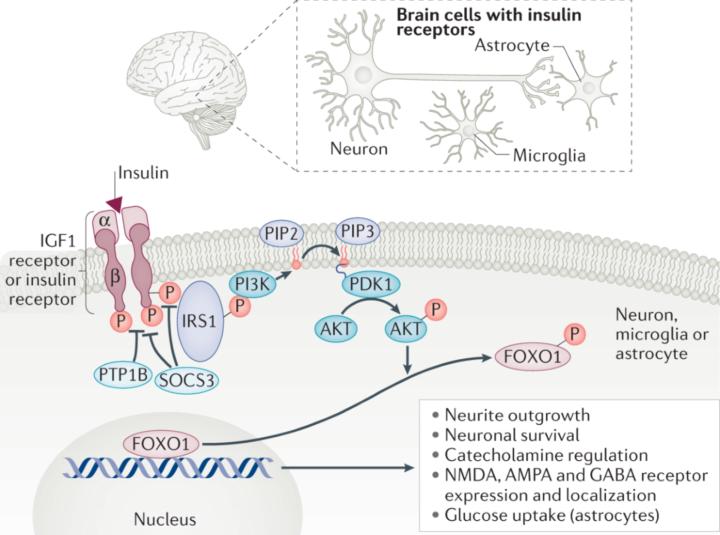
Write something
You’re Fit, Lean… and Foggy? The Hidden Form of Insulin Resistance No One Is Talking About.
Thanksgiving has a way of slowing life down just enough for you to actually notice what’s been happening underneath all the noise. You sit with people you love, share a big meal, breathe for the first time in weeks, and suddenly you’re able to feel things you usually ignore. Maybe this year, in that moment of stillness, you noticed something strange: your body feels strong, your training is dialed in, your glucose looks perfect… but your brain doesn’t match how good the rest of you feels. Maybe you felt foggy after a meal, mentally slower than usual, overwhelmed for no reason, or just “not as sharp,” even though everything on paper says you’re metabolically healthy. If that sounds familiar, you are not alone and there’s a real physiological explanation behind it. How can someone be physically insulin-sensitive yet mentally sluggish? How can your muscles get the fuel they need while your brain feels like it’s running on fumes? This article is written for you, to answer exactly that question. Central insulin resistance is the phenomenon where your brain becomes insulin-resistant even when the rest of your body remains highly insulin-sensitive. Many people experience this as a strange mismatch: they feel physically strong, metabolically healthy, and steady during training, yet their cognition feels foggy, slow, unpredictable, overwhelmed, or “under-powered.” This article explains why that happens, what the mechanisms are, how to recognize the patterns, and how to fix them, using simple language without sacrificing the biochemical accuracy that clinicians and experts expect. The first thing to understand is that the brain handles insulin differently from the rest of the body. Your muscles and liver respond directly to insulin in the bloodstream. The brain does not. For insulin to have any effect in the brain, it must cross the blood–brain barrier, bind to receptors on neurons, activate the PI3K-Akt pathway, and allow neurons to take up and use glucose. If anything disrupts that sequence, neurons will be under-fueled even if the entire rest of the body is functioning perfectly. This is why someone can have excellent fasting glucose, low insulin, perfect CGM curves, and still feel terrible cognitively. The brain can become insulin-resistant before the body gives any signal.

Only 10 Almonds in a Gallon?! The Almond Milk Scandal No One Talks About
Almond milk is often marketed as a clean, healthy alternative to dairy, but most people don’t realize how far the store-bought version drifts from that image. Commercial almond milk is usually made with two percent almonds or less, which means an entire gallon contains only about one to one and a half ounces of actual almonds, roughly ten to fifteen nuts in total. That tiny amount of almond material is nowhere close to the nutrient density people expect. Whole almonds provide vitamin E, magnesium, polyphenols, healthy fats, protein, and fiber, but almost none of that survives the industrial milk-making process. What you end up drinking is mostly water, sweeteners, thickeners, and synthetic vitamins that create the illusion of nutrition rather than providing real nutrient density. Another piece people rarely hear about is the quality of the almonds used. The whole, beautiful, uniform almonds you find in grocery store bags are grade-A nuts. Those do not go into almond milk production. Manufacturers use what are considered subgrade almonds broken, discolored, insect-damaged, or aged nuts that didn’t make the cut for consumer shelves. These fragments may have been sitting in storage longer, may be partially oxidized, and sometimes have higher risk of mold exposure or poor handling. Since consumers never see the almonds in the final beverage and the taste is masked with vanilla or sweeteners, producers use the cheapest raw materials possible and rely on additives to fill in the gaps. The agricultural side is also more complicated than people think. Almonds are one of the most heavily sprayed crops in the United States, especially in California where most almonds are grown. The orchards are commonly treated with herbicides like glyphosate, pesticides such as chlorpyrifos, imidacloprid, and other neonicotinoids, and fungicides like propiconazole. Several of these chemicals are systemic, meaning they move into the plant tissue itself rather than remaining on the outer surface. Because commercial almond milk production doesn’t involve washing or peeling in the way consumers wash fresh produce, and because pasteurization does not remove chemical residues, those contaminants can remain present in the nuts used for milk. When you combine heavy pesticide use with the reliance on the lowest-quality almonds, the final product can contain more undesirable residues than most people would ever guess.
The Origin Story: Apples, Phlorizin, and Glucose Wasting
My friend and colleague @Brian Graham was actually the one who first mentioned that SGLT2 inhibitors trace their roots back to apples. I love stories like this where science and trivia overlap so I dug in to learn more and wanted to share what I found. Big thanks to Brian for sparking the curiosity and inspiration behind this one. In the 1830s, chemists isolated a natural compound from apple tree bark (and to a lesser degree from the apple itself) called phlorizin (also spelled phloridzin). It’s a glucoside of phloretin, part of the polyphenolic family that gives apples some of their antioxidant and metabolic effects. Researchers later discovered that when animals or humans were given phlorizin, they started excreting large amounts of glucose in their urine even though their blood glucose wasn’t dramatically elevated. This was puzzling, because under normal physiology, the kidneys reabsorb nearly all filtered glucose in the proximal tubule to prevent energy loss. That phenomenon glucosuria without hyperglycemia was the first clue that the kidneys had a specific glucose transport mechanism that could be pharmacologically blocked. By the mid-1900s, scientists identified that glucose reabsorption occurs through sodium-glucose co-transporters (SGLTs), primarily SGLT2 in the proximal tubule (responsible for ~90% of glucose reuptake) and SGLT1 further downstream. Phlorizin turned out to be a competitive inhibitor of both SGLT1 and SGLT2, preventing glucose reabsorption and causing its excretion. However, phlorizin itself wasn’t a good drug it was poorly absorbed orally and was rapidly hydrolyzed in the intestine to phloretin, which blocked other transporters nonspecifically and caused GI issues. So, researchers asked: Could we make a stable, orally bioavailable derivative that selectively blocks SGLT2? That question directly led to the modern SGLT2 inhibitor class. Medicinal chemists used the phlorizin scaffold as the blueprint, modifying the C-glucoside linkage (to resist enzymatic cleavage) and tweaking ring structures to increase selectivity for SGLT2 over SGLT1.
Part 2 — Repairing the Lipid Language: Protocol Design for Autoimmune and Neurological Recovery
True healing happens when inflammation completes its full life cycle initiation, resolution, and regeneration. Part 1 explained the molecular language that allows this to happen: plasmalogens providing structural resilience and SPMs sending the biochemical “stand down” signal. Part 2 translates that science into practice how to rebuild this communication system through nutrition, supplementation, and targeted protocols that restore the body’s ability to self-regulate. Re-establishing the Resolution Loop In chronic disease, the inflammatory cycle stalls between the attack and repair phases. The body keeps releasing cytokines like TNF-alpha and IL-6, but never transitions to the clean-up molecules such as resolvins or maresins. The therapeutic goal is not to shut off inflammation but to reopen the loop so that the same immune cells that fought can now rebuild. That means supplying the missing raw materials, reactivating the enzymes that make SPMs, and rebuilding the membranes that store them. Step 1: Rebuild the Substrate Plasmalogen Restoration The first step is to fix the infrastructure. Without plasmalogens, cell membranes lose flexibility, mitochondrial function suffers, and omega-3 reserves for SPM production vanish. The quickest way to rebuild this pool is through precursors like Prodrome Neuro and Prodrome Glia, which contain ether-linked lipid backbones that bypass the damaged peroxisomal step. Taken daily, they replenish both phosphatidylcholine- and phosphatidylethanolamine-based plasmalogens. In practice, most people use six capsules of each per day for a repletion phase lasting three to six months, followed by a maintenance dose of two to four daily. The improvement is gradual but measurable patients often report clearer cognition, calmer mood, and reduced oxidative stress within eight weeks as their membranes regain elasticity. Step 2: Supply the Builders Cofactors for Peroxisomes Even when precursors are provided, the enzymes that finish plasmalogen synthesis need help. B-vitamins act as catalysts; magnesium stabilizes ATP; zinc and iron activate the transferases that move fatty chains; and CoQ10 supports the redox cycling inside the peroxisome. A simple daily stack vitamin B3 (as niacinamide 250 mg), vitamin B5 (as pantothenate 500 mg), magnesium glycinate (200–400 mg), zinc (15–30 mg), and CoQ10 (100 mg) creates the metabolic environment for these pathways to work. This foundational nutrition turns the “factory lights” back on so that plasmalogens can be built efficiently rather than burned.
The Forgotten Lipid Language — How Plasmalogens and Specialized Pro-Resolving Mediators Coordinate Cellular Resolution
When most people hear the word “fats,” they think of calories or cholesterol. In cellular medicine, fats are far more than fuel they are the words and grammar of biological communication. Each lipid molecule is like a syllable that tells the cell when to inflame, when to repair, and when to rest. Two families sit at the heart of this conversation: plasmalogens and SPMs, or Specialized Pro-Resolving Mediators. Plasmalogens are ether-linked phospholipids that form part of every cell membrane and act as antioxidant shock absorbers. SPMs are signal molecules made from omega-3 fats that end inflammation once the threat has passed. When either group is depleted, the body can start an inflammatory “sentence” but forget how to end it. The result is chronic inflammation, autoimmunity, and neurodegeneration. Lipids are fat-like molecules that don’t dissolve in water. Inside the body, they serve three key roles: they build membranes, store energy, and act as messengers. You can imagine a cell membrane as a coral reef. The rigid corals are phospholipids that maintain structure, while cholesterol and glycolipids act like flexible anemones allowing movement and adaptability. Nutrients, ions, and hormones swim through this reef, and the condition of the lipids determines how well communication flows. Plasmalogens stand out because of their unique structure. Every phospholipid has three parts a glycerol backbone, two fatty acid tails, and a phosphate-based headgroup. Plasmalogens replace one fatty acid tail with a special vinyl-ether bond. This small chemical tweak gives them superpowers: they resist oxidation, store high-energy electrons, and can neutralize free radicals faster than most antioxidants. If a regular phospholipid is a car tire, a plasmalogen is a run-flat tire that can take damage and keep working. Plasmalogen production starts in the peroxisome, the cell’s detox and lipid-assembly center, and finishes in the endoplasmic reticulum, the folding factory. The process begins with DHAP (dihydroxyacetone phosphate), a byproduct of glucose metabolism. The enzyme GNPAT attaches the first fatty acid, then AGPS swaps that bond for an ether linkage using a long-chain alcohol. These steps need cofactors such as iron, magnesium, NADPH, and vitamin B5. The partially built molecule then travels to the ER, where desaturation forms the vinyl double bond, and the headgroup is added, completing the plasmenyl-phospholipid structure. The result is either plasmenylethanolamine or plasmenylcholine, depending on which headgroup is used.
1-12 of 12

skool.com/castore-built-to-adapt-7414
Where science meets results. Learn peptides, training, recovery & more. No ego, no fluff—just smarter bodies, better minds, built to adapt.
Powered by





